“Growing” Your Business or Trying to Fill a Bucket with a Hole in It?
Why Smart Processes Are Key to Scaling Your Organization
As companies grow, the excitement of expansion often brings a slew of challenges. One common trap is the rush to hire new staff without setting up the right processes to support such growth. This approach can create significant inefficiencies and stumbling blocks that not only hinder long-term success but also limit the company’s ability to scale effectively.
The more people an organization hires, the more complex things become. There are varying methods of how tasks should be executed, who should do them, and what the overall expectations are. This often results in more dependencies on leaders, more meetings, delays, redundant tasks, repeated efforts, and increased errors.
We frequently work with organizations that have recently added 20 to 50 new employees and have yet to see any improvement in velocity. Things seem chaotic, and the quality of work has dropped. This scenario is all too common, and if you’re considering hiring to grow, or if you’re already in this situation, you might be overlooking the necessity of processes.
When teams are small, informal “growing by doing” methods are enough since it’s easy to keep tabs on what’s happening and how things need to get done. However, this approach doesn’t scale.
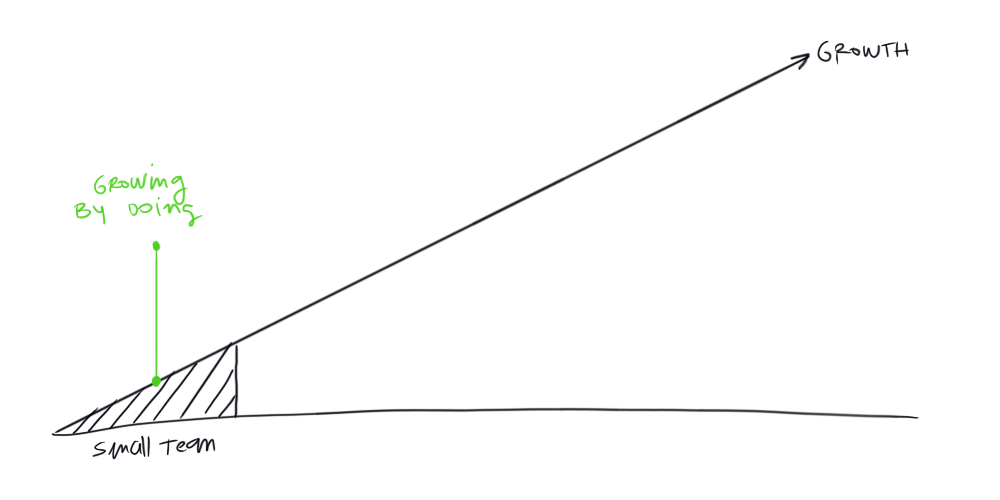
The only way to efficiently handle growth is to implement solid processes.
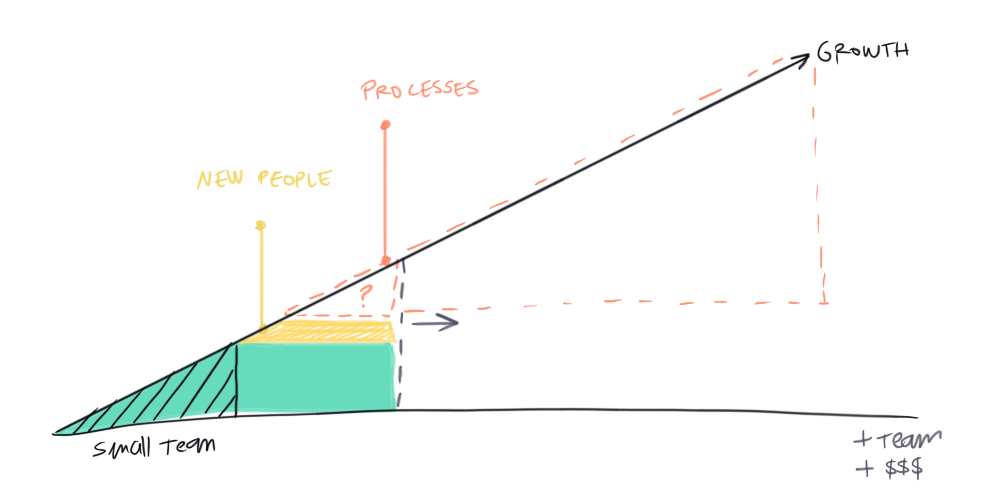
Over time, as your company grows, you’ll find the need to continuously review and enhance your processes to support this growth.
The Problem with Traditional Processes
Many organizations have a handbook or document outlining required procedures. But let’s be honest, have you read it? Chances are, it’s forgotten shortly after it’s distributed. No one wants to sift through a lengthy document every few months hoping to find the information needed to do their job right.
Relying solely on process documentation ISN’T the solution.
It burdens managers and team members who must pass on their knowledge while juggling their own tasks.
This constant need for guidance from leaders — prevents team members from working independently and making confident decisions.
This method also creates inconsistencies and unfair processes. Leaders might discuss processes with some employees but not others, leading to a disparity in how tasks are completed. This not only fosters unfairness but also silos within the team.
So, What’s the Solution?
If traditional documents and top-down instructions fail, what’s the alternative?
The answer lies in creating dynamic, accessible, and easy-to-understand processes that empower all employees.
These processes should be ingrained in the daily workflow and supported by tools that make information readily available to everyone when they need it. A good example is Nova.
Don’t do:
- DON’T write a lengthy document with all your processes.
- Your processes should NOT restrict your employees but rather give them autonomy and the capacity to “shine”.
- DON’T rely on key managers to share knowledge and maintain a minimum quality of work. This creates silos, unfair processes, and bottlenecks that delay overall progress.
A simple start:
If you’re wondering how to start and are concerned about spending too much time on this, think again. Every time you explain something to your team, start a new project, or take on a new client, you are already defining your processes from scratch. So, the next time you start, at least do the following:
- Create a checklist of must-dos. This should at least serve as a way to ensure all team members know what must be done or evaluated.
- Define roles and responsibilities.
If your company is a team of 10 or more people, looking to grow or increase margins, you may need to start thinking about processes to facilitate growth.
The Allure of Scaling Through Staffing
It’s a familiar scene in rapidly growing companies: sales are up, customer demand is increasing, and the pressure to deliver more — and do it quickly — is overwhelming. In response, companies often rush to hire new employees. On the surface, this seems like the quickest fix to meet demand.
More hands on deck means more work done, right?
However, this strategy can backfire if not managed with care.
Hiring more staff without proper planning often leads to increased spending on salaries, benefits, and training. Additionally, without the necessary infrastructure to integrate these new hires effectively, productivity can actually decrease.
New employees need time to learn the ropes, and without streamlined processes, this ramp-up period can be prolonged and costly.
The Crucial Role of Processes
Processes are the backbone of any organization, though perhaps NOT in the way you have always thought about them. We all know that process documents can become irrelevant as things change. However, the right processes provide a roadmap for tasks, ensure consistency in quality, and enable scalability by creating predictable and repeatable patterns of work. They do this by giving team members the autonomy to make decisions and work according to certain company standards, allowing them more freedom to focus on areas where they can utilize their superpowers. Without these systems in place, each new hire adds complexity rather than capability.
A common mistake is not aligning new processes with increased headcount. For example, if a company doubles its sales team but doesn’t update its customer relationship management (CRM) processes, the existing workflows become bottlenecks. Sales representatives might find themselves waiting for approvals, struggling with outdated tools, or duplicating efforts unknowingly.
Implementing Scalable Processes
The key to successful scaling — balancing the addition of new employees with the creation of robust processes — lies in anticipation and strategic planning. Here’s how organizations can approach this:
- Forecast Based on Metrics: Use data to predict growth and determine when new hires are needed. Plan for both the headcount and the infrastructure required to support that growth.
- Prepare for Growth Before You Grow: Before hiring, spend time improving processes to increase efficiency and reduce errors, ensuring new employees understand their roles and expectations.
- Standardize Onboarding: Create a standardized onboarding process that quickly and efficiently brings new employees up to speed. This should include training on tools, company culture, and specific job roles.
- Automate Where Possible: Automation can significantly reduce the workload on staff by handling repetitive tasks, allowing employees to focus on more strategic, value-added activities.
- Regularly Update Processes: As the business grows, revisit and revise processes. Strategies that worked for a 20-person company may not suit a 100-person company. Regular reviews can identify pain points and areas for improvement.
- Foster a Culture of Continuous Improvement: Encourage employees to provide feedback on processes. This fine-tunes workflows and boosts employee engagement and satisfaction.
- Evaluate different Software solutions: Determine what software each department needs, such as a CRM for the sales team and Jira for development/engineering. Ideally, your processes should be centralized within 2–3 tools to act as the organizational brain, like Nova, maintaining your company’s intellectual property and guiding the team.
Tools & Tips
When defining your processes, start by getting a piece of paper and creating a list of necessary tasks. Also, consider what your team needs to think about and evaluate. Processes are often more about evaluating and considering various aspects and understanding the minimum thought processes needed to adhere to company criteria, rather than just listing tasks and milestones.
So, grab a piece of paper and write down how your team moves from point A to point B. What do they need to consider? What must they evaluate or think about?
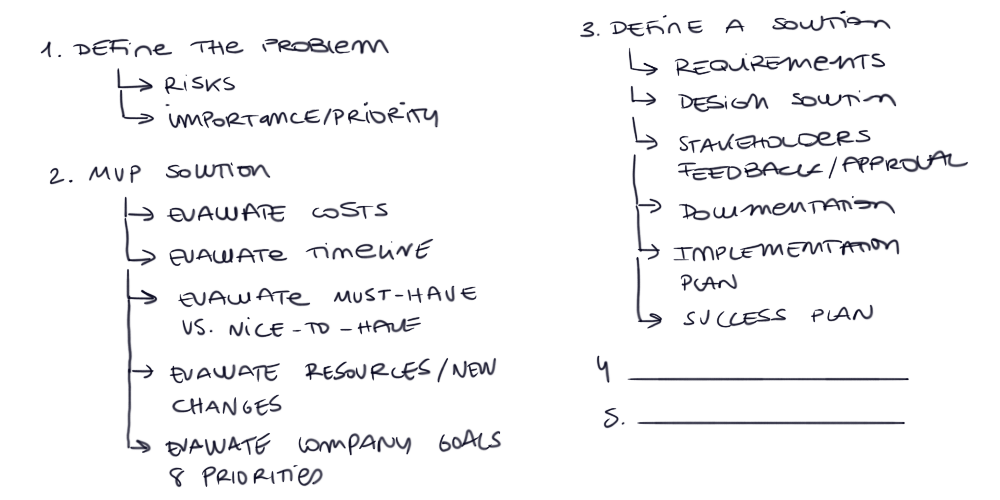
In here now you can see that the key is to define the “success criteria” the secret sauce that makes your organization unique and brings everyone together.
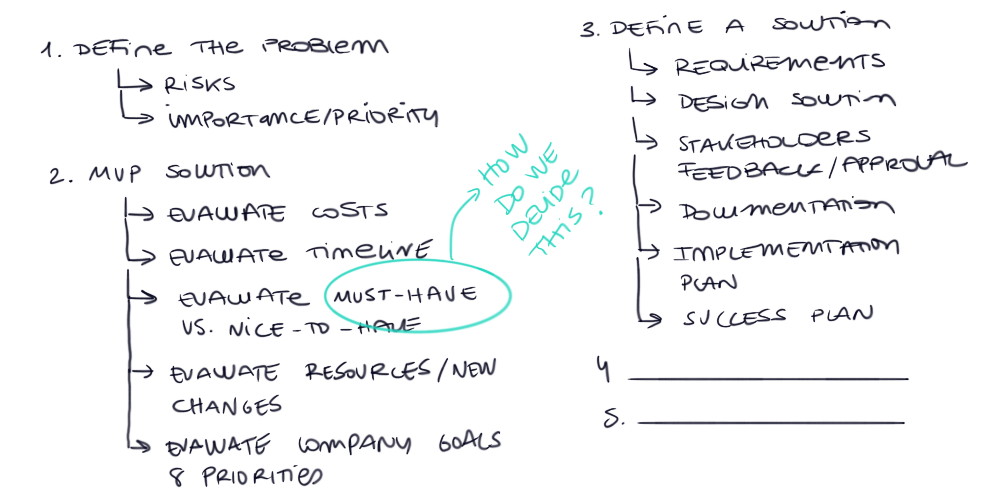
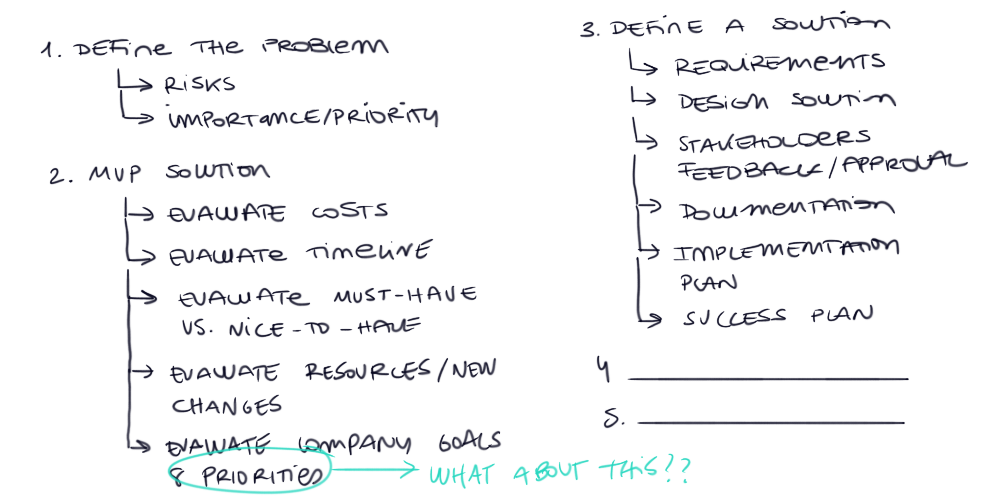
It should be clear that this is a framework, not specific instructions. It should help them start faster and work with confidence, knowing they are moving in the right direction.
This can look different for each department. For example, sales teams often use a CRM to manage their leads and need a framework to gather client information, usually filled out using a template that might reside in a tool like Nova, where the team or leader can add tips and suggestions.
The Development or Engineering team might rely on a tool like Jira to manage their tasks and tickets. While all their tasks are there, the thinking criteria and quality evaluation they must go through, as well as knowledge previously gathered by other team members, need to be accessible in a way that helps them understand decision-making processes and evaluate important aspects before releases or executing solutions. As a complementary tool, they often have access to something like Nova.
Teams like Marketing manage multiple tools for social media, ads, etc., but for decision-making and defining their strategy and thinking processes, they need tools like Nova. There, they have access to the thinking processes and frameworks of how they work. The same applies to product teams, designers, etc.
Tools
- Task Management: Tools that help you keep track of your tasks and make it easy for teams to visualize who is doing what and track progress. Teams may use different tools for this, like Asana, Jira, etc.
- CRM: Tools to manage sales leads and customers. Ideal for teams with large sales teams that depend on their long-term relationships and sales strategies to grow or bring enterprise customers to the company. CRM tools are often needed.
- Processes and Knowledge Management: Tools that guide teams through each step of the process, hold everyone’s knowledge, and help manage collaboration internally and with stakeholders, making it easy for organizations to scale by sharing the company IP. For example, Nova. All your knowledge and decisions should be accessible here.
- Other Industry-Specific Tools: Additional tools will be needed to support each department, for example, a tool to schedule social media posts for the marketing team, or a data analytics tool for the data analyst team.
Expanding an organization’s workforce without enhancing and scaling its processes is like trying to fill a bucket with a hole in it.
No matter how much water you add, you’ll struggle to achieve your goal if you don’t first fix the leak.
By implementing robust processes and preparing the infrastructure to handle new hires, companies can ensure that their growth leads to increased productivity and success, rather than chaos and inefficiency. The goal is to grow smart, not just fast, turning the excitement of expansion into sustainable progress.
Resources:
- Nova at novatools.org
- Sales qualia (Triangle of transformation)
